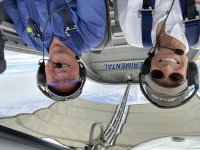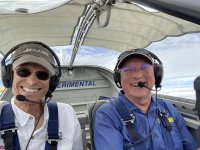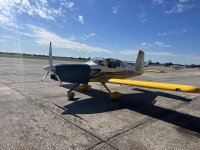A few teaser pics….
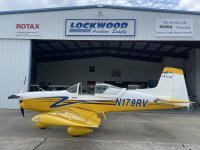
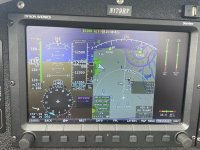
It’s not often that you get to fly both the oldest and the newest airplane of a specific type - and they are the same plane!
I spent the day in Sebring, Florida with “Mr. Rotax” himself, Phil Lockwood. Phil unveiled his ongoing project, the RV-9A with a Rotax 915iS that was displayed at this year’s Airventure. I first saw the airplane and examined it in detail last spring, but was asked to keep it under my hat until its public unveiling. The airframe is Serial Number 1, loaned to Lockwood for the project by Vans, and while you’ll have to wait for a full review coming in Kitplanes in coming months, I can share first impressions with this group.
This a mature (and still maturing) engineering project that has produced a remarkable plane, capable of excellent speed and efficiency at altitude. It can easily bust through existing Vne, and that is something being worked - I won’t quote numbers to keep everyone involved happy (and myself out of trouble), but I will say that we were easily cruising in the mid-170’s (KTAS) at 12.5k Burning 7.4 gph of Swift 94 - and the airplane does even better higher up.
It is stable, and recently passed a major spin testing program - handles well, is as honest as any RV-9 I have flown, and frankly was delightful to fly. The long nose? It looked normal after a few hours with the plane - I hardly notice in anymore.
Lockwood is planning on producing a conversion kit - price TBD…not cheap, but when is performance ever cheap? Last week I flew homebuilt twin-engined flying boat that has a kit price of 1.5 million dollars….and they have several on order. There’s always someone that thinks it’s worth it to them! The Rotax -9 might be one of them to someone that wants a true altitude cruiser….
No….we’re not inverted! But those are RVGrins!


It’s not often that you get to fly both the oldest and the newest airplane of a specific type - and they are the same plane!
I spent the day in Sebring, Florida with “Mr. Rotax” himself, Phil Lockwood. Phil unveiled his ongoing project, the RV-9A with a Rotax 915iS that was displayed at this year’s Airventure. I first saw the airplane and examined it in detail last spring, but was asked to keep it under my hat until its public unveiling. The airframe is Serial Number 1, loaned to Lockwood for the project by Vans, and while you’ll have to wait for a full review coming in Kitplanes in coming months, I can share first impressions with this group.
This a mature (and still maturing) engineering project that has produced a remarkable plane, capable of excellent speed and efficiency at altitude. It can easily bust through existing Vne, and that is something being worked - I won’t quote numbers to keep everyone involved happy (and myself out of trouble), but I will say that we were easily cruising in the mid-170’s (KTAS) at 12.5k Burning 7.4 gph of Swift 94 - and the airplane does even better higher up.
It is stable, and recently passed a major spin testing program - handles well, is as honest as any RV-9 I have flown, and frankly was delightful to fly. The long nose? It looked normal after a few hours with the plane - I hardly notice in anymore.
Lockwood is planning on producing a conversion kit - price TBD…not cheap, but when is performance ever cheap? Last week I flew homebuilt twin-engined flying boat that has a kit price of 1.5 million dollars….and they have several on order. There’s always someone that thinks it’s worth it to them! The Rotax -9 might be one of them to someone that wants a true altitude cruiser….
No….we’re not inverted! But those are RVGrins!
Attachments
Last edited:



